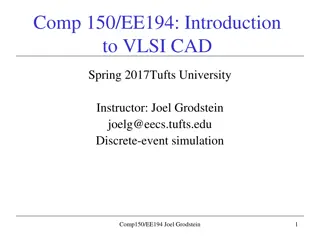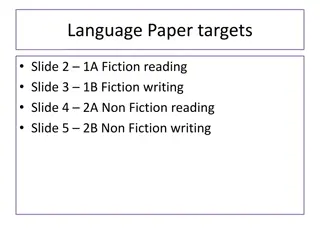
Understanding Empathy in Fictional Narratives: Knight's Analysis
Explore the Mental Simulation Model and the Folk Model in fiction, addressing empathetic responses to fictional characters. Knight's discussion delves into the practical reasoning mechanism and the challenges of estimating the mental states of characters, offering a critical perspective on the black box concept.
Download Presentation

Please find below an Image/Link to download the presentation.
The content on the website is provided AS IS for your information and personal use only. It may not be sold, licensed, or shared on other websites without obtaining consent from the author. If you encounter any issues during the download, it is possible that the publisher has removed the file from their server.
You are allowed to download the files provided on this website for personal or commercial use, subject to the condition that they are used lawfully. All files are the property of their respective owners.
The content on the website is provided AS IS for your information and personal use only. It may not be sold, licensed, or shared on other websites without obtaining consent from the author.
E N D
Presentation Transcript
Chapter 18 In Fictional Shoes: Mental Simulation and Fiction by Deborah Knight
Mental Simulation Model This model attempts to account for empathetic responses to fictional characters.Most theories of emotional response to fictions focus on feelings directed at ourselves (what we find ourselves feeling). What does this involve? Empathetic responses derive from how we accomplish two tasks associated with estimating what is it like to be a fictional character? : 1) Estimating what a fictional character will do; and 2) Estimating how a fictional character feels (to estimate how things are for them).
The Folk Model Knight begins by using the same folk psychological explanation for how we manage to estimate what real people are thinking and feeling (because we often need to understand what is going on for them) that Neill used. What s that? We interpret the present and possible future behavior of others by assuming their desires, interests, needs, habits, personality, beliefs, and feelings influence and explain their behavior by assuming they are just like us, but only differ in their desires, interests, needs, Knight s Innovation The folk model fails to include something unique about what influences our estimates of the mental states of fictional people. [Fiction (text- or film-based) adds] fictional structure as focalizers of metaphoric, symbolic, thematic or generic significance. What does this mean?
Whats good about Folk Psychological Simulation Theory [E]xplaining mental simulation [in the theory of mind] includes terms such as make-believe, pretence, dramatic enactment, imaginative projection, and social role-playing and these all natural features we take to be part of how films engage the viewer. How this explains empathy: we suspend ( quarantine ) our own beliefs, desires, interests, fears, hopes etc. and imaginatively entertain the other s beliefs and desires and then run it through our practical reasoning mechanism to produce an estimate of the other s beliefs and desires, etc. But what is this practical reasoning mechanism , Knight asks. Her answer: it is some kind of black box in which processing of the information associated with other s beliefs/desires/etc. occurs.
Knights Problem with this Black Box The black box that is conceded to be the practical reasoning mechanism must contend with temptations of competing desires and the need to select one action from a range of options and this seems to demand a level of cognitive processing that is impossible for a background capacity for cognitive processing . I seems to require that we get it right when estimating what others think, feel, etc. To understand her complaint, you need to think about how hard it would be to figure out which of a variety of different possible inputs (=causes of possible behavior in a fictional character) would produce which variety of different possible outputs (=actual behaviors of a fictional character), and how often we get things wrong in real life.
Two Objections to Knights Complaint: But this is something we successfully do with other people, so why not with fictional characters whose inputs are in various ways more predictable and better distinguished from various possible inputs by the magic of the fictional narrative s devices. We don t need to be right in imagining another s reaction to a situation for the simulation theory to be thereby made suspect. People mistake the intentions/inner states of others ALL THE TIME, but that shows that accuracy is not essential if the model is to characterize how we come to develop empathy for others!!!
Discuss Knights objections to the practical reasoning mechanism and the counters to those.
Simulating Fictions Knight s best point: the maker of the fiction takes pains to tell us what the beliefs, desires, inner mental states of the fictional character are so we won t have to use our simulation device to figure it out for ourselves. Roeg s Don t Look Now cannot be understood if we only react to the death of the child scene at the beginning of the film sympathetically since then the Julie Christie character s engagement with the psychic sisters would not lead us to take seriously enough that character s evident belief that her dead child is attempting to warn her and her husband of something terrible that is going to happen to the husband (I won t tell you what that is so you won t have the ending of the film spoiled). If we fail to take events in this part of the film seriously from her point of view, we would not take the final events as we do (with horror that is partly based on her horror at the loss of her child).
Section IV: What Empathetic Feelings Involve 1. Empathy is not shared feelings . 2. Rather, empathy requires that your feeling generate my feeling. 3. The empathy I feel is mediated by a belief I have, so empathy is a cognitive state[:] it is essentially a matter of my holding second-order beliefs about your beliefs. JP: that means I feel anxiety with you if I believe that you believe you are going to flunk out of school, not only because I sense that you are anxious! 4. My feelings are not identical to those of the one I empathize with because my anxiety, felt on their behalf, is based on my beliefs about their beliefs, whereas their anxiety is due to their beliefs that they are in danger of flunking out of school. (so the affect can be identical, but the difference is not affective; it is, rather, cognitive [concerns the difference between the beliefs that support my anxiety vs. the beliefs that support theirs]).
5. This leads to a paradox in the case of empathic responses to fictional characters: they don t have beliefs! 6. This can be overcome by replacing the cognitive role of my beliefs about their beliefs with my imagining what their beliefs, desires, etc., might be. (Feagin s solution to the paradox at #5) 7. Neill rejects Feagin s solution. He thinks that what actually goes on is that in empathizing with another we partly are understanding how things are with her and this does not require that we get their mental states right (this, many think, takes imaginative engagement with a fictional character too far!), but moreso a matter of coming to know what it is like to have certain beliefs, desires, hopes, and doubts.
Section 5 Neill looks for reinforcement for these intuitions by looking at them through the lens of Milan Kundera s novel (and later, Philip Kaufman s film), The Unbearable Lightness of Being and its theme concerning compassion. Neill takes what Kundera calls compassion to be fundamentally the same as what he has been calling empathy. Kundera: This kind of compassion [ ] signifies the maximal capacity of affective imagination, the art of emotional telepathy [my emphasis] .






















